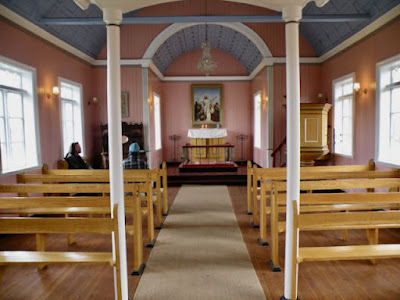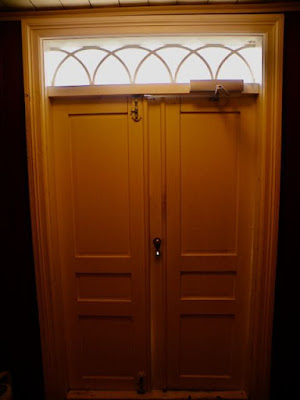At the Settlement Center (Museum) in Borganes in the morning we learned: Five hundred and fifty years ahead of Columbus, in the days before the sextant, courageous Scandinavians dared to sail across the Atlantic. These adventurers discovered a large untouched island and claimed the land as their own. The Settlement Era of Iceland had begun. We know the names of three hundred and fifty of these individuals, and we know their stories, thanks to The Book of Icelanders and The Book of the Settlement.
In the afternoon while most of our tour group chose to go to the spa at the hot springs we visited yesterday, Hubby and I chose to go back to the hotel. There was a geocache in the village calling our name on the day of Plan B. When we drove into our village of Reykholt, I noticed a historical sign. I set off with my camera to check it out.
Words like Medieval Church and Medieval Road caught my attention. I wandered up the road.
the entrance to the graveyard
Do you know the difference between a graveyard and a cemetery? A graveyard is next to a church. A cemetery is not. I did not know the difference until today.
wish I knew more about this piece of art
I checked out some of the dates on the headstones
this one dates back from 1801-1891
all kinds of grave markers
part of the graveyard
the church built in 1886-1887 replaced the medieval church at this location
now a historical building restored to its original build
(click photo to enlarge)
the altar area
ceiling above the altar
an organ from early 1900s
the pulpit
the church entrance doors from the inside
a map marking and naming each grave or burial plot
So all of this was very interesting but it wasn't until I found more historical signs near the church and graveyard when my interest was peaked even more. Archeologists have uncovered foundations and remains leading back to 1100.
site of Medieval Church buildings beginning in the 1100s

foundation of farm buildings and house
more about the fort later in the blog
Snorri Sturluson (1179-1241)
Sturluson was one of the 350 individuals who settled Iceland when the Vikings began to move from Norway looking for new land. He settled in Reykholt.
(remember to click to get a larger photo)
the location of the royal grove, the gardens were to the left,
near the underground steam tunnel
unique design in the road by the graveyard
part of the stone wall in front of the church
and around the side of the graveyard and church
notice the larger upright stone
and notice how the stones in the wall have changed in size
I believe the fort wall was on the right to the upright stone
(that's our hotel in the background)
I walked back to the hotel and asked the hotel staff a question about the church. They directed me to an information center in the basement of the NEW church. It also had a museum and is a study center for Medieval history and a research center. WOW!
built in 1996 to replace the 1886-87 church building
About a dozen headstones similar to this one were on display in the gift shop. Some of them dated in the 1800s. But all the writing carved into the stone and the decorative detail was so interesting. I did not have time to go through the museum dedicated to Snorri Sturluson and the displays of items uncovered in the archeological digs, but I would have liked to explore it.
the museum information
replica of an entrance to a Medieval Church
On my way back to the hotel (about a city block walk) I noticed this turf roofed building and the red sign below. WOW! the remains of a medieval road and forest path? A medieval house? I later learned Hubby had been IN that house to find the local geocache! And he did not take any photos or read any signs! By that time I was too cold and tired to walk another block to explore it.
The village of Reykholt has a population of 60. The only business is the hotel and restaurant. The modern church and the school building host festivals and research groups.
the backside of the school and now conference center
the front door to the school
our lodging for two nights
Having the time to explore the medieval village ruins made my day! I did not miss going to the spa!
And from Wikipedia if you really want to know more:
Reykholt (Icelandic pronunciation: [ˈreikˌhɔl̥t]) is a village in the valley of the river Reykjadalsá, called Reykholtsdalur. It is part of Borgarfjörður, Western Region.
Reykholt was at one time one of the intellectual centers of the island and had for many years one of the most important schools of the country. The poet and politician Snorri Sturluson lived in Reykholt during the Middle Ages. Sturluson's records of the Old Norse language and mythology of medieval Iceland are invaluable to modern scholars. Remains of his farm and a bathroom with hot pot and a tunnel between the bath and the house can still be visited. The Snorrastofa Cultural / Research Centre was established in Reykholt on September 6, 1988, with opening ceremonies attended by Vigdís Finnbogadóttir, President of Iceland and King Olaf V of Norway.
Today, the village has 60 inhabitants, a school centre and a library concentrating on the works of Snorri Sturluson. A statue of Snorri by Gustav Vigeland can be found here. Archeologists are still working here and finding medieval remains. In the vicinity, Japanese scientists are doing research on the aurora borealis (the northern lights).
About 20 km from Reykholt, there are the lava waterfalls Hraunfossar*. It is also possible to go from there to the caves Surtshellir in the lava field Hallmundarhraun (about 35 km). On the way to Borgarnes*, people pass by the hot springs of Deildartunguhver.* They exceed all the other hot springs of the country in their output of hot water: 180 litres/second at 97 °.
*denotes places we have visited the last two days







































No comments:
Post a Comment
Thanks for your comments!